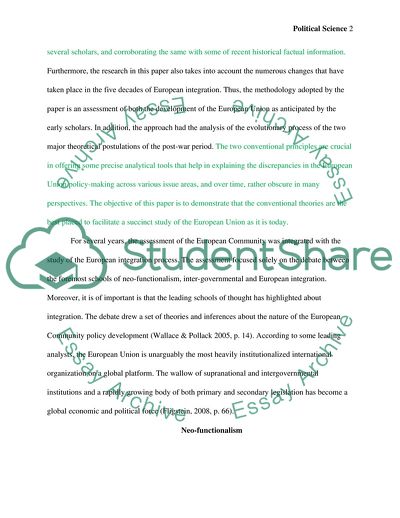Cite this document
(Study of Today's European Union: Theoretical Perspective Research Paper Example | Topics and Well Written Essays - 3000 words, n.d.)
Study of Today's European Union: Theoretical Perspective Research Paper Example | Topics and Well Written Essays - 3000 words. https://studentshare.org/politics/1845954-to-what-extent-are-the-conventional-theories-of-the-european-integration-neo-functionalism-and-intergovernmentalism-of-relevance-for-the-study-of-todays-european-union-refer-to-two-critical-theoretical-approaches-when-answering-the-question
Study of Today's European Union: Theoretical Perspective Research Paper Example | Topics and Well Written Essays - 3000 words. https://studentshare.org/politics/1845954-to-what-extent-are-the-conventional-theories-of-the-european-integration-neo-functionalism-and-intergovernmentalism-of-relevance-for-the-study-of-todays-european-union-refer-to-two-critical-theoretical-approaches-when-answering-the-question
(Study of Today'S European Union: Theoretical Perspective Research Paper Example | Topics and Well Written Essays - 3000 Words)
Study of Today'S European Union: Theoretical Perspective Research Paper Example | Topics and Well Written Essays - 3000 Words. https://studentshare.org/politics/1845954-to-what-extent-are-the-conventional-theories-of-the-european-integration-neo-functionalism-and-intergovernmentalism-of-relevance-for-the-study-of-todays-european-union-refer-to-two-critical-theoretical-approaches-when-answering-the-question.
Study of Today'S European Union: Theoretical Perspective Research Paper Example | Topics and Well Written Essays - 3000 Words. https://studentshare.org/politics/1845954-to-what-extent-are-the-conventional-theories-of-the-european-integration-neo-functionalism-and-intergovernmentalism-of-relevance-for-the-study-of-todays-european-union-refer-to-two-critical-theoretical-approaches-when-answering-the-question.
“Study of Today'S European Union: Theoretical Perspective Research Paper Example | Topics and Well Written Essays - 3000 Words”. https://studentshare.org/politics/1845954-to-what-extent-are-the-conventional-theories-of-the-european-integration-neo-functionalism-and-intergovernmentalism-of-relevance-for-the-study-of-todays-european-union-refer-to-two-critical-theoretical-approaches-when-answering-the-question.


